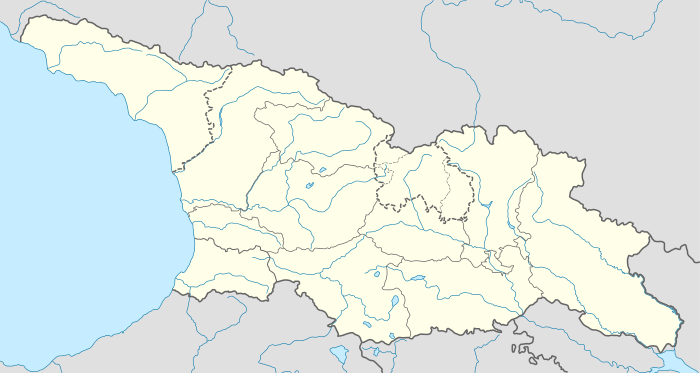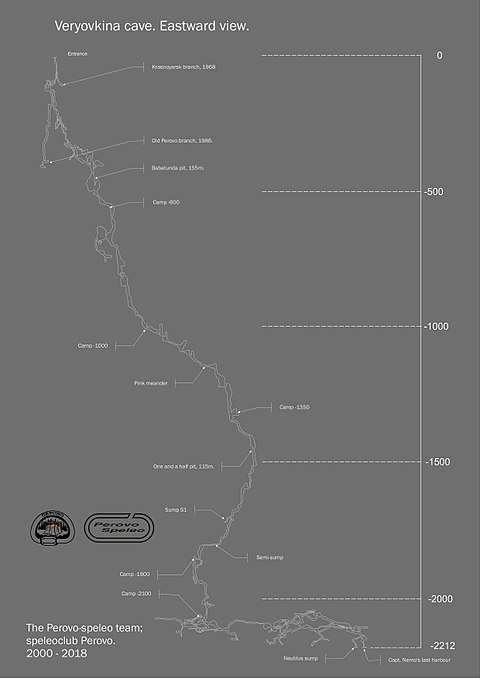Veryovkina Cave
| Veryovkina Cave | |
|---|---|
 | |
| Location | Georgia |
| Coordinates | 43°24′56″N 40°21′23″E / 43.41556°N 40.35639°ECoordinates: 43°24′56″N 40°21′23″E / 43.41556°N 40.35639°E |
| Depth | 2 212 m |
| Length | 13 500 m |
| Discovery | 1968 |
| Geology | Limestone |
Veryovkina Cave (Russian: Пещера Верёвкина, Georgian: ვერიოვკინის მღვიმე) is the deepest-known[1][2] cave on Earth. It is situated 2309 meters above sea level[3] in the Arabika Massif of the Gagra Range of the Western Caucasus, in the Gagra district, in Abkhazia, Georgia. The entrance of the cave with a cross section of 3 × 4 m is located on the pass between the Krepost (Fortress, 2384 m[4]) and Zont (2382 m[5]) mountains, closer to the slopes of Mt. Krepost. The depth of the entrance shaft is 32 meters.
Naming
Initially, in 1968, the cave was assigned the name S-115 which was later replaced by P1-7, and in 1986 it was renamed after Alexander Veryovkin. Caver and cave diver Alexander Veryovkin died in 1983 while exploring a siphon in the cave Su-Akan, located in the Sary-Tala massif, Kabardino-Balkaria Republic of the Russian Federation.

.jpg)
Exploration
- 1968 - the cave was discovered by cavers from Krasnoyarsk. They reached a depth of 115 meters and marked it on the map as S-115.
- 1982 - the cave was discovered for the second time by the expedition of the "Perovo" speleoclub from Moscow. It was marked as P1-7. In the years 1983 - 1986 cavers from the same team continued exploration and reached the depth of 440 m.
- From 1986 to 2000 work in the cave did not take place.
- From 2000 to 2015 the speleoclub "Perovo" and its team "Perovo-speleo" continued research at the cave bottom. Despite all the efforts the cave depth remained at 440 m.
- August 2015 - cavers from the speleoclub "Perovo" finally discovered a new shaft, its depth was later determined to be 156 m. This discovery opened the way to a series of later discoveries.
- June 2016 - the expedition of the team "Perovo-speleo" took place, to a depth of 630 m.
- August 2016 - a joint expedition of the "Perovo-speleo" team and the "Perovo" speleoclub reached the depth of 1010 m.
- October 2016 - the expedition of the team "Perovo-speleo" deepened the cave to 1350 m.
- February 2017 - the expedition of the "Perovo-speleo" team reached the depth of 1832 m. The cave advanced to the second deepest in the world, after Krubera (Voronya) cave.
- Beginning of August 2017 - the speleoclub "Perovo" explored the cave to the depth of 2151 m. An ancient collector of the karst aquifer system with extensive horizontal tunnels, not typical for the Arabica massif, was discovered. Veryovkina became the second super deep cave (over 2 km) and the deepest accessible without diving equipment.
- Second half of August 2017 - the "Perovo-speleo" team reached the depth of 2204 m, thus setting a new world depth record. Huge system of more than 6000m of subhorizontal passages below the -2100m was discovered and surveyed.
- March 2018 - another expedition of the same team added more than a kilometer of tunnels to the cave map. They also measured the depth of The last Nemo station terminal siphon lake. It was 8.5 meters and so the total cave depth reached 2212 meters.
See also
References
- ↑ "Speleoclub "Perovo" (Moscow) Updates". Ukrainian Institute of Speleology and Karstology. Archived from the original (VRML) on 2018-01-24. Retrieved 2009-04-04.
- ↑ WORLDS DEEPEST CAVES Compiled by: Bob Gulden — Sept.22, 2017
- ↑ Esiava, Badri. "Пещера Веревкина в Абхазии: претендент на рекорд и новый вид жуков" [Veryovkina Cave in Abkhazia: aspirant for a record and a new species of beetles] (in Russian). Retrieved 8 May 2018.
- ↑ Kovinov, Dmitrij. "Поход по Арабике через перевалы Дзоу и Шу, 21 - 24 августа 2016" [Trekking through Arabica over the passes Dzou and Shu, 21 - 24 August 2016] (in Russian). Retrieved 8 May 2018.
- ↑ "Гора Зонт" [Zont Mountain] (in Russian). Retrieved 8 May 2018.